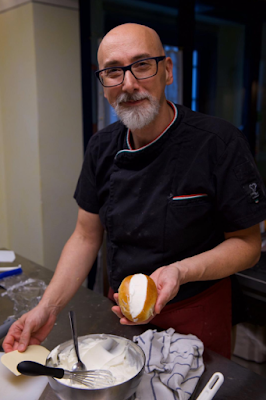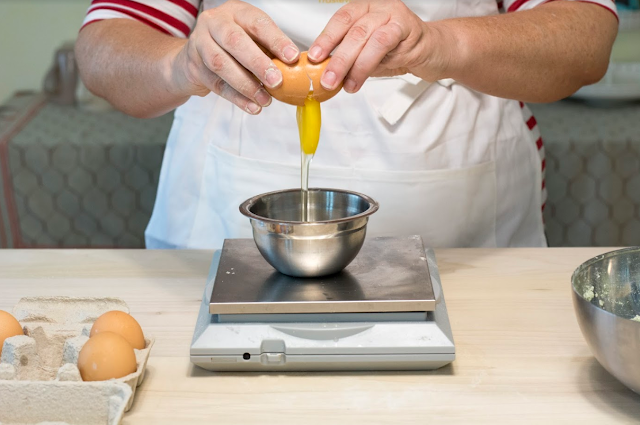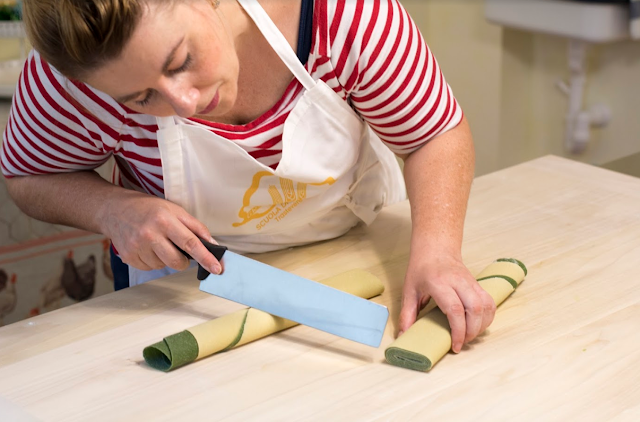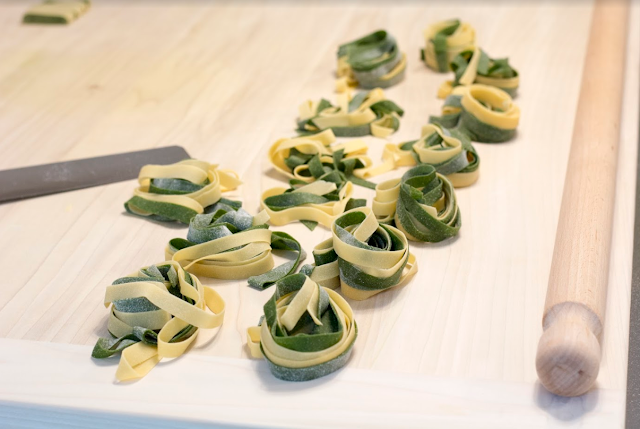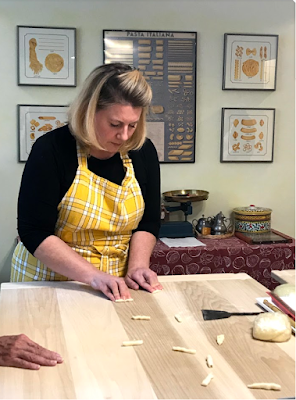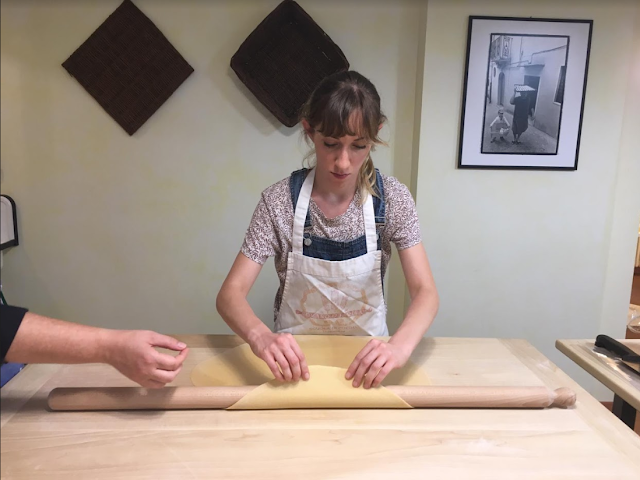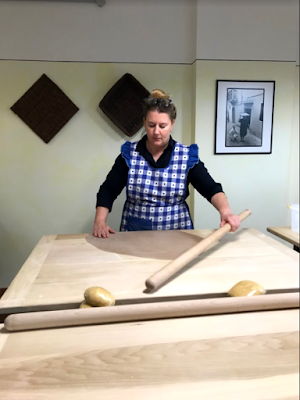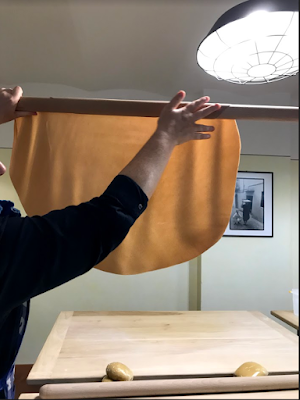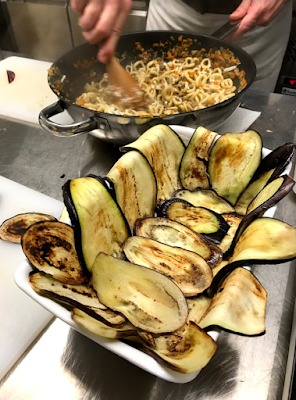Grano & Farina Scuola di Cucina, Part II
As you'll remember from this post here (Part I) one of the most exciting things that happened to me in 2019 was the discovery of Grano & Farina Scuola di Cucina, a cooking school here in Rome that is, in short, a cut above all the rest. Quick refresher: G&F offers lessons are hands-on, educational, and superbly executed, hopping cleanly over the usual bruschetta/tiramisu' routine so often offered in the Eternal City (nothing wrong with that; just not my style) and focusing instead on more complex subjects like knife skills, fresh pasta, bread making, and pastry, to name just a few. It is at Grano & Farina that I learned the ins and outs of making what had previously seemed impossibly difficult croissants and cornetti, how to temper and prepare my own chocolates, and how to truly understand and properly enjoy the glorious stuff that is olive oil; in short, I've been able to tackle and learn about aspects of cooking and baking that I'd like not have attempted without a little (expert) guidance.
The minds behind such a wonderful place, you might ask?! That would be Julia and Pino Ficara, two incredibly talented and knowledgeable culinary instructors (knowing how to cook is one thing; knowing how to teach how to cook is a whole different beast). Bonus: they also happen to be two of the loveliest, funniest people you'll ever meet.
In Grano & Farina Part I, I focused more on my classes with Pino, a chef with an incredibly wide range of abilities and a profound knowledge of anything and everything to do with cooking and baking.
As you may recall, he is the master behind some of the best bread, pizza, and pastries I've ever tasted.
If there's a part I, there must of course be a part II! On to my classes with Julia, a sfoglina, or expert pasta-maker, one who works without the use of a machine but rather with a rolling pin, producing fresh pasta (tortellini! fettuccine! ravioli!) equal to that of any Italian nonna, not surprising given she has learned from many a nonna and studied pasta making up in Bologna (the capital of hand rolled pasta). She is a walking pasta encyclopedia, a wealth of knowledge when it comes to different types of flour, proportions of hydration, kneading methods, and tricks and tips that make forming tricky shapes a breeze.
Here she is at work, whipping up notoriously tricky trofie (the pasta Holy Grail for me; I can't get a handle on this one) not to mention twisty tortellini and toothsome maccheroni al ferro, just a few of the countless shapes she has mastered. Below, the expert in action, whipping up fresh spinach and egg tagliatelle:
Ehem: unless you've been living under a rock, you'll have noticed that 2019 has been defined by a slight obsession with fresh pasta --detailed in the blog's Pasta Series -- which has been in great part fueled by Grano & Farina.
The pasta class I've taken with Julia have been essential to learning about the wonderful stuff that is handmade pasta and subsequently improving my pasta-making skills. With no further ado: details on Southern, Northern, and Pasta Grannies Regional Pasta classes below!
SOUTHERN PASTAS
The cuisine of Italy varies greatly from region to region (Sicilian cuisine with its pine nuts and capers and couscous has nothing to do with Bolognese cuisine, with its tagliatelle and mortadella and ragu', for example) and pasta is no exception; each region of Italy has its own tradition, and G&F is attentive to this, dividing their lessons up accordingly. In Southern Pastas, I discovered the magical stuff that is semola/water pasta dough (my favorite pasta dough to date! #pastanerd) traditional in places like Puglia and Sardinia. With Julia I learned that water stands in for the eggs usually found in the pastas up North, indicative of the relative poverty that the south of Italy experienced; that semola flour is made with flour of a harder grain, making for a longer cooking time than the quick-cooking fresh egg pasta, and also for a pasta that is pleasantly chewy; and that the addition of a little salt in the dough strengthens the gluten network that develops with a little kneading. The result? A pasta dough that is incredibly versatile, used to make everything from gnocchetti sardi to fusilli to orecchiette to cavatelli to maccheroni al ferro (think long, fat, hand-rolled spaghetti) all of which were demonstrated expertly by G&F's resident pastaia. Orecchiette -- a shape that had seemed impossible to me before -- was broken down easily by Julia, and with a little practice, more or less conquered not long after (see proof here!) We whipped up two sauces with Chef Pino to go with our pastas -- broccoli rabe and breadcrumbs for the orecchiette, amatriciana sauce for the maccheroni, but this varies class to class -- and then dried and took home the rest of the pastas, thus keeping the pasta party going!
NORTHERN PASTAS
With Carla Tomasi, I learned all about the beauty of a good pasta machine -- my first introduction to homemade pasta! -- eventually going on to buy one of my own, which I love dearly and use regularly. I felt however that my pasta education would not be complete without learning how to roll out pasta with a rolling pin -- tirare la sfoglia con il matterello -- the (pre-pasta machine) method traditional up in the North of Italy. Lucky for me, Julia only uses a rolling pin (#nomachinesallowed!) which makes for a slightly different pasta than the one rolled out with a machine; machine-rolled pasta produces very smooth-textured pasta, while pasta rolled out on a wooden board gives the pasta a rougher, slightly more interesting texture that sauce clings to more easily. Which method you use is all a matter of preference, and as I personally see the merits of both, I signed up for G&F's Northern Pastas class. Joined by my cooking buddy Sarah (it's hard to find people as passionate or as interested in cooking as I am -- yay for Sarah) I learned all about pasta all'uovo, or egg pasta, rolled out until paper thin (you should be able to read a newspaper placed under it) with a very long rolling pin. Now: if you watch Julia demonstrate this (which you can see here) this process looks deceptively easy; if you're a complete matterello novice however, it takes a bit of getting used to. With Julia's guidance -- your hands should go from your hip, outwards and upwards, in a triangular Christmas tree sort of shape! rotate the dough from 12 to 2 to 4 to 6 to 8 to 10 on the clock! push a little harder and quicker on the rolling pin when you get to the edge of the sfoglia, to even it out! be very careful with your sfoglia on the last few rolls; it's delicate! -- we had more or less gotten the hang of it by the end of the lesson (grazie Julia!) With our beautiful sheets of pasta dough, we learned to make everything from the fat, sauce-catching tubes that are paccheri to the tiny, delicate ridged pasta that are lumachelle and the crazy, nonna-in-a-rush strapponi (where the aforementioned pasta dough is wrapped around the rolling pin, ripped off in pieces -- strappare means to rip, in Italian) and thrown directly in to the boiling water. Not to mention: fettuccine, tagliatelle, garganelli, and strozzapreti. Ahh, the pastabilities!
PASTA GRANNIES - REGIONAL PASTAS
Julia -- Pasta Queen that she is -- not only teaches pasta at Grano & Farina, she is also involved in the Pasta Grannies Project. If you're not familiar: Pasta Grannies is a YouTube channel/Instagram profile started by Brit Vicky Bennison, documenting nonne from all over Italy who make fresh pasta, thus both preserving the tradition and also promoting it. Happily enough, the project -- with its nearly 450,000 followers -- shows that perhaps the art of handmade pasta -- something that doesn't seem to quite fit in with the desire for speed, efficiency, instant gratification that defines today's lifestyle -- isn't lost quite yet. The PG project has had so much success that Vicky recently published a Pasta Grannies Cookbook (details here) which Julia contributed to (much of the pasta you see photographed is made by her, and her hands make more than a few cameo appearances). In G&F's Pasta Grannies class, you can make pasta recipes taken from the project, thus covering pastas from all over Italy in one lesson. In this class, we traveled up North to Lombardy and made pizzoccheri, buckwheat pasta noodles (usually tricky to roll out and cut, but a piece of cake if you have a Julia Ficara to guide you) tossed with nutty Valtellina cheese, potatoes, cabbage, and lots of butter, a pure, rib-sticking dream to eat; a timballo hailing from Sicily, made with tiny ringed anellini pasta, tossed in a spiced beer and beef ragu', tossed with ricotta salata, wrapped in eggplant, baked, and sliced; and strapponi, the aforementioned on-the-go style pasta from Tuscany, made this time with a little whole wheat flour and served with earthy, seasonal porcini mushrooms. Heaven!
But wait, there's more! G&F offers a class on gnocchi -- potato, semolina based gnocchi alla romana, and gnocchetti sardi! -- not to mention a whole class on filled pastas, a part of my pasta education that is still lacking (I've only learned how to make ravioli so far). Pasta aside, I hope to tackle bread, pizza, and French desserts (so many classes, so little time) at G&F in 2020, and rest assured you'll hear all about it. To close the post -- the expert pastaia and the pastaia-in-training up in Fara Sabina, where I was lucky enough to help Julia out with a 30 person (!!!) pasta class not long ago. Long live pasta!



